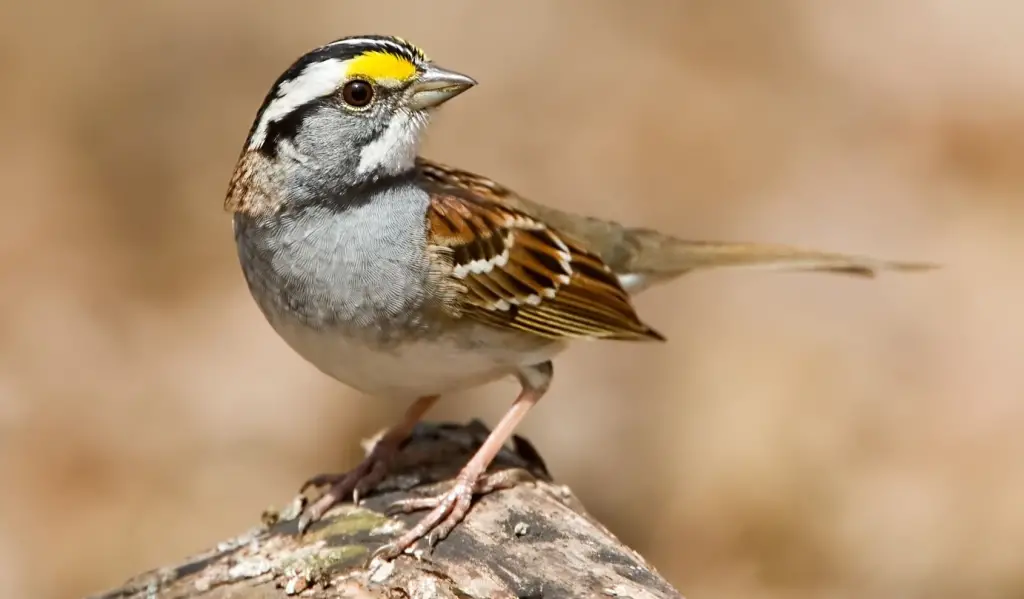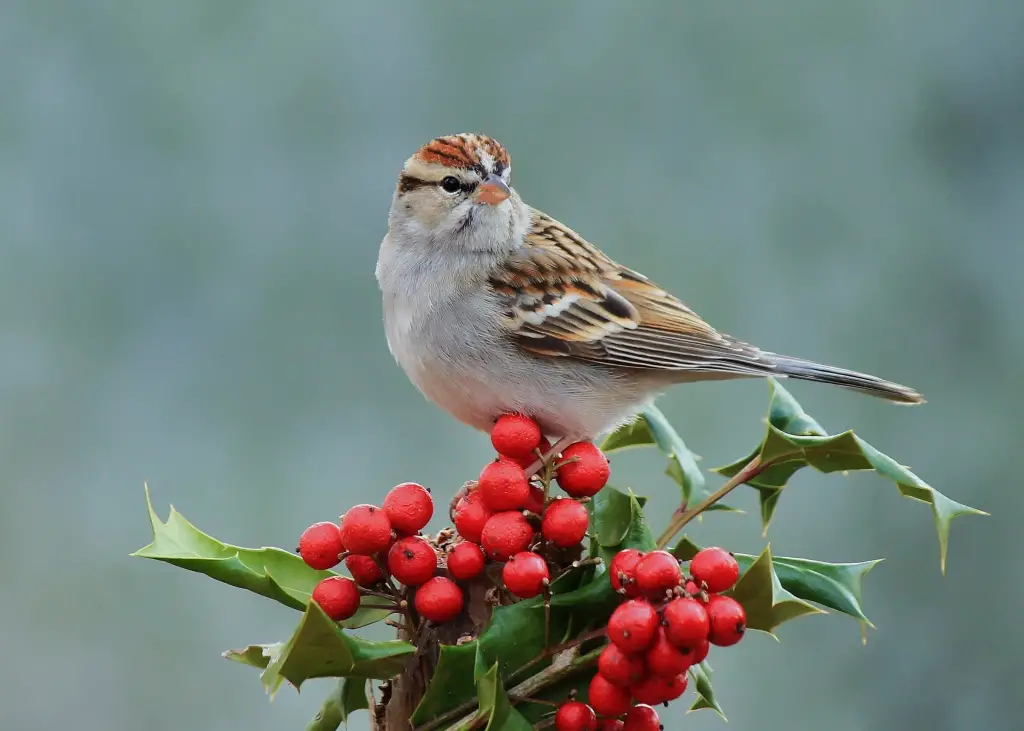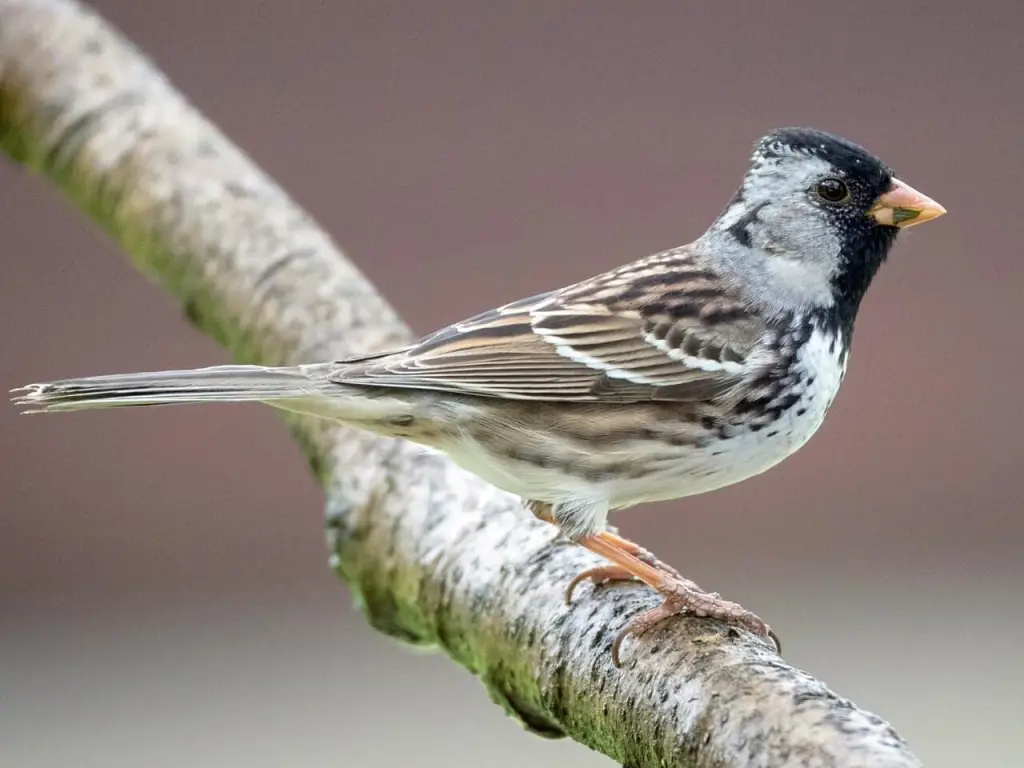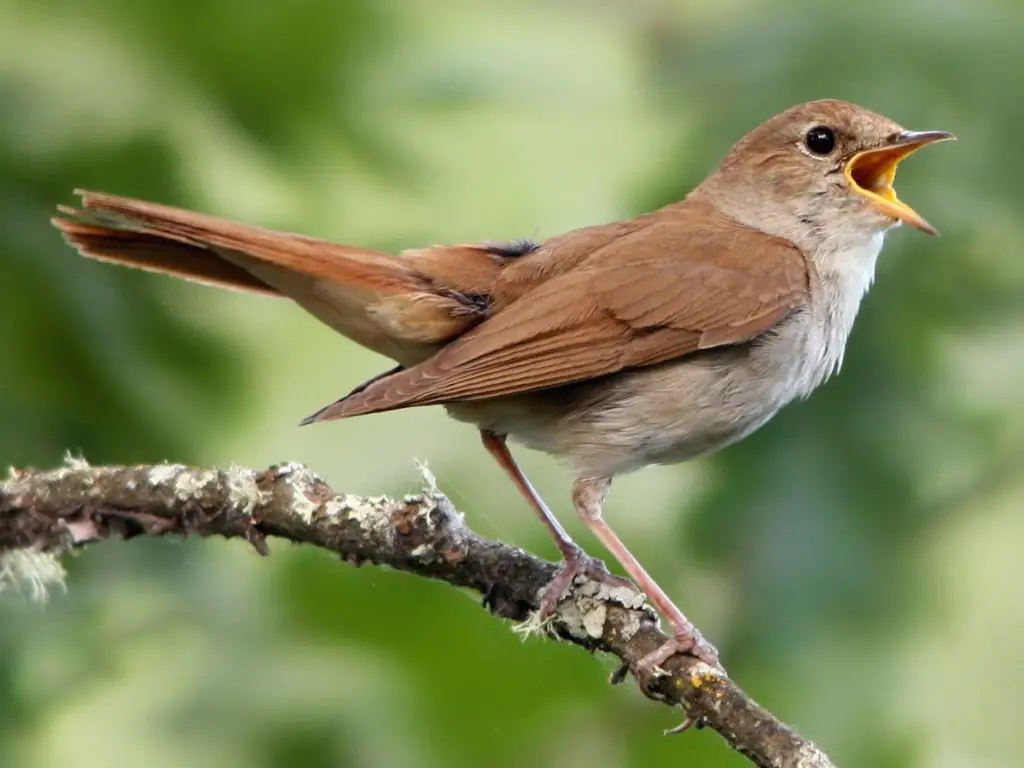One particularly enchanting group of birds are the ones with contrasting hues of brown bird with white stripes on head.
These striking features offer camouflage in various habitats and make them stand out for birdwatchers and nature enthusiasts.
In this guide, we will journey across continents, exploring the world of these beautiful creatures.
From the dense woodlands of North America to the sprawling grasslands of Europe, there are over 10+ brown birds with white stripes on their heads that grace our world with their unique beauty.
10+ brown bird with white stripes on head
There are lots of brown birds in the world with white stripes on head. We have listed most popular 10 of them to you.
So, Let’s see the amazing list :
1. White-throated Sparrow

Scientific Name: Zonotrichia albicollis
Lifespan: 3-4 Years
Wingspan: 21 to 23 cm
Native: Canada and the northeastern USA.
The White-throated Sparrow is easily identifiable by its bright white throat patch and contrasting black and white stripes on its head.
These birds typically have either tan-striped or white-striped head patterns, with the latter being more conspicuous. They also sport a yellow lore (a spot between the eye and the beak) which is a small yet distinctive feature.
Habitat
During breeding season, White-throated Sparrows inhabit coniferous and mixed coniferous-deciduous forests, especially in areas with clearings or edges. In the winter, they are more versatile and can be found in woodlands, gardens, fields, and shrubby areas.
Range
These sparrows breed in Canada and the northeastern parts of the United States. Come winter, they migrate to the southeastern U.S. Some might venture as far west as California and as far south as Central America.
Diet
White-throated Sparrows are ground foragers. Their diet mainly consists of seeds, but they also eat insects during the breeding season.
Song & Calls
Their song is a series of clear whistles that often sound like they’re saying, “Oh sweet Canada, Canada, Canada.” Their call is a sharp “tsip.”
Conservation
While the White-throated Sparrow is currently not at significant risk, like many birds, they benefit from conservation efforts that protect their natural habitats.
If you’re in North America during the right seasons, listening for their song or watching for their distinctive head patterns can be a rewarding way to spot these charming sparrows. Whether you’re a seasoned birdwatcher or a casual enthusiast, the White-throated Sparrow is always a delightful find.
2. White-crowned Sparrow

Scientific Name: Zonotrichia leucophrys
Lifespan: 3-5 Years
Wingspan: 20 to 22 cm (7.9 to 8.7 inches)
Native: North America
Adult White-crowned Sparrows are distinguished by their bold black and white stripes on the crown of their heads. They possess clear gray breasts and bellies, with brown and streaky wings and backs. Juvenile birds have brown and tan stripes on their heads instead of the characteristic black and white of adults.
Habitat
White-crowned Sparrows inhabit various habitats. During breeding seasons, they are found in tundras, shrublands, and mountainous areas. In winter, they’re more flexible and can be spotted in open areas, fields, gardens, roadsides, and urban environments.
Range
Their breeding range spans northern parts of Canada and Alaska, as well as mountainous regions in the western U.S. During winter, they migrate southward, covering most of the U.S. and parts of northern Mexico. Some populations remain year-round along the Pacific Coast and the southwestern U.S.
Diet
Primarily seed-eaters, White-crowned Sparrows feed on a variety of seeds from grasses and weeds. They also consume insects, especially during the breeding season.
Song & Calls
Their song varies widely across different regions but typically consists of clear, whistled notes. The most common call is a sharp “pink” sound.
Behavior
These sparrows are known to “double-scratch” when foraging. This involves jumping forward and backward quickly to uncover food from the ground.
Conservation
White-crowned Sparrows are widespread and abundant. While they face threats like habitat destruction and collisions with man-made structures, their populations are currently stable.
Observing the White-crowned Sparrow, especially during its song, provides a simple pleasure to both amateur and avid birdwatchers. Their presence in a variety of habitats, including urban areas, makes them one of the more accessible bird species for viewing.
3. Lark Sparrow

Scientific Name: Chondestes grammacus
Lifespan: 3-5 Years
Wingspan: About 27 to 30 cm (10.6 to 11.8 inches)
Native: North America
Lark Sparrows are medium-sized sparrows with a distinctive head pattern. They boast a rich chestnut and white striped head with a clear white stripe above the eye and a bold black patch on the cheek. Their backs are streaked, and they have a mostly clear chest with a central dark spot, akin to a miniature meadowlark.
Habitat
Lark Sparrows favor open habitats. They are primarily found in areas with scattered trees and shrubs like grasslands, prairies, pastures, and even open woodlands. They tend to avoid dense forests.
Range
These sparrows breed in the central and western parts of the United States, some parts of southern Canada, and extend into northern Mexico. During the winter months, they migrate to the southern U.S. and further into central Mexico.
Diet
The diet of Lark Sparrows consists of both insects and seeds. During the breeding season, they lean more towards insects, which provide the necessary protein for growing chicks. Seeds make up a larger portion of their diet in non-breeding months.
Song & Calls
Their song is a series of clear, melodious notes, often including mimicry of other birds. The song is variable, but it usually has a clear, bell-like quality. They also have distinctive call notes which can be described as sharp, sweet, or tinkling.
Behavior
Lark Sparrows are ground foragers. Their mating display is notable: males fly up singing and then descend with a series of wing flutters and held wings, giving an impression of a butterfly flight.
Conservation
While Lark Sparrows have experienced some declines due to habitat loss, they are still relatively widespread and not considered globally threatened. Nevertheless, preserving grassland habitats is vital for their continued success.
For bird enthusiasts, the sight and sound of a Lark Sparrow can be a delightful experience, particularly given their distinctive appearance and song among the often-cryptic world of sparrows.
4. Chipping Sparrow (breeding adults)

Scientific Name: Spizella passerina
Lifespan: 2-7 Years
Wingspan: 20 to 25 cm (7.9 to 9.8 inches)
Native: North America
Breeding adult Chipping Sparrows showcase a bright, rufous cap on their heads, which contrasts sharply with their clear gray underparts and crisp white belly. A distinguishing feature is the black line that runs through their eyes, creating a striking contrast against a gray face.
Their backs are streaked brown and they have a brown tail. The beak is small and conical, ideal for their seed-based diet, and is usually black in color.
Habitat
During the breeding season, these sparrows favor open woodlands, especially those with scattered trees and grassy understories. They are also common in gardens, parks, and suburban areas, making them one of the more adaptable sparrow species.
Range
In their breeding range, Chipping Sparrows can be found across most of Canada, throughout the United States, and into parts of northern Mexico.
Diet
While they are known to eat a variety of insects during the breeding season, Chipping Sparrows are primarily granivorous, favoring seeds. This dietary switch to insects provides the necessary protein for their offspring.
Song & Calls
The song of the Chipping Sparrow is a long, trilled “chip” that can vary in pitch but is generally repetitive. It’s a characteristic sound in many North American forests and neighborhoods during the warmer months.
Behavior
Breeding males can often be seen perched high on a tree or post, singing to establish territory or attract a mate. They are ground foragers, often seen in small flocks, hopping about and scratching the ground in search of food.
Conservation
Chipping Sparrows are abundant and widespread. While they face some challenges due to habitat loss and fragmentation, their populations remain robust in many areas.
The rufous-capped appearance of the breeding Chipping Sparrow, combined with its persistent trilled song, makes it a noticeable and cherished part of many North American habitats during the warmer months.
5. American Tree Sparrow

Scientific Name: Spizelloides arborea
Lifespan: 3-5 Years
Wingspan: 21 to 23 cm (8.3 to 9.1 inches)
Native: North America
The American Tree Sparrow is a small bird with a rounded head, a short bill, and a long tail. One of its standout features is its rufous cap and eyeline, which contrasts with a gray face and underparts.
A dark central spot can be found on its chest, and its back is streaked with brown and black. The bird’s bill turns yellow in the summer and darker in the winter.
Habitat
Although the name suggests an affinity for trees, American Tree Sparrows often prefer brushy areas, especially in winter. In the breeding season, they choose the tundra of the Far North.
Range
During the breeding season, these sparrows inhabit the Arctic tundra of northern Canada and Alaska. When winter arrives, they migrate south to the central and eastern United States, some parts of the western U.S., and even into northern Mexico.
Diet
Their diet consists of a mix of seeds and insects. While they primarily consume seeds in the winter, insects become a significant portion of their diet during the breeding season.
Song & Calls
Their song is a series of sweet, high-pitched notes followed by a trill. Their call is a soft, high-pitched “tseet.”
Behavior
American Tree Sparrows are ground foragers, often seen hopping on the ground or among shrubs looking for food. They form flocks in the winter and can often be seen mixed with other sparrow species.
Conservation
Currently, American Tree Sparrows are not globally threatened. However, like many Arctic-breeding birds, they might face challenges in the future due to climate change and the associated changes to their breeding habitats.
The American Tree Sparrow’s presence, with its gentle songs and soft calls, adds charm to the open fields and brushy areas it frequents during the colder months, offering bird enthusiasts a delightful sight amidst winter’s chill.
6. Harris’s Sparrow
Scientific Name: Zonotrichia querula
Lifespan: 5-7 Years
Wingspan: 22 to 26 cm (8.7 to 10.2 inches)
Native: central United States

Harris’s Sparrow boasts a distinctive look with its bold black face, crown, and throat. These dark features contrast sharply against its gray upper parts and white underbelly.
Juveniles and non-breeding adults have a browner appearance with a less defined face pattern, though some traces of the black facial markings remain.
Habitat
During its breeding season in the northern tundras, Harris’s Sparrows are found in areas with stunted trees and shrubs. In the winter, they prefer dense thickets, shrubby fields, and feeders in more open areas. They often join mixed-species flocks during this time.
Range
Unique among American sparrows, Harris’s Sparrows breed exclusively in the northernmost parts of central Canada, specifically in the Northwest Territories and Nunavut. As winter approaches, they migrate to the Great Plains of the U.S., ranging from North Dakota down to Texas.
Diet
Their diet consists mainly of seeds, though they also consume insects, especially during the breeding season. In the winter, they can be found foraging on the ground in search of seeds and can be attracted to bird feeders.
Song & Calls
The song of the Harris’s Sparrow is a beautiful, clear whistle, followed by a series of rich notes. Their call, when flying or alarmed, is a sharp “pink” sound.
Behavior
These sparrows are ground foragers, typically scratching the earth in search of food. They are somewhat social birds and can be found in mixed flocks during the winter.
Conservation
While the Harris’s Sparrow is not currently classified as endangered, it’s worth noting that their exclusive breeding range in the northern tundras makes them vulnerable to habitat changes due to factors like climate change.
The sight of a Harris’s Sparrow, especially a boldly patterned adult, is a treat for bird enthusiasts. Its striking appearance and clear song make it a standout among its more subtly colored sparrow kin.
7. Brown Creeper

Scientific Name: Certhia americana
Lifespan: 4-5 Years
Wingspan: 19 to 21 cm (7.5 to 8.3 inches)
Native: North America
The Brown Creeper is aptly named for its brown, streaked plumage, which blends seamlessly with the bark of trees. Its underparts are white, and it has a thin, down-curved bill ideal for probing into bark crevices. The tail is long and stiff, helping it to support itself on tree trunks as it creeps upward.
Habitat
Brown Creepers inhabit mature forests, with a particular affinity for coniferous or mixed coniferous-deciduous woods. They are also found in woodlots, parks, and cemeteries with mature trees.
Range
Their range spans much of North America. In the northern parts, including much of Canada and the northern U.S., they breed primarily in the summer. Some areas in the Pacific Northwest and parts of the eastern U.S. see them as year-round residents. During winter, they extend their range to include much of the southern U.S.
Diet
Brown Creepers feed primarily on small insects and spiders, which they meticulously glean from tree bark. Occasionally, they might consume seeds or other plant matter.
Song & Calls
The song of the Brown Creeper is a high, thin series of notes that can be easy to overlook. Their call is a soft, high-pitched “tsee.”
Behavior
Their signature behavior involves starting at the base of a tree and spiraling upwards, using their stiff tail for support as they probe bark crevices for food. Once they reach the top, they fly down to the base of another tree and start the process again.
Conservation
Brown Creepers are not currently considered threatened, but like all birds, they can be affected by habitat loss and degradation.
Despite their unobtrusive nature, Brown Creepers are a delight to spot, offering a unique birdwatching experience as they trace their intricate paths up tree trunks, ever in search of their next meal.
8. Common Nightingale

Scientific Name: Luscinia megarhynchos
Lifespan: 1 to 3 Years
Wingspan: 21 to 25 cm (8.3 to 9.8 inches)
Native: Europe and western Asia
The Common Nightingale is a relatively plain-looking bird with a brown upper part and a pale underbelly. Despite its unassuming appearance, its song is unmatched in its richness and complexity. The bird has a reddish tail, which contrasts with its brown back, and a small, sharp beak.
Habitat
Nightingales thrive in a variety of habitats, including open forests, scrublands, gardens, and thickets. They have a particular fondness for dense undergrowth, which provides them with both protection and the insects they feed on.
Range
Common Nightingales breed in parts of central and southern Europe and western Asia. Come winter, they embark on a long migration journey to sub-Saharan Africa, where they spend the colder months.
Diet
Their diet consists primarily of insects, including ants, beetles, and caterpillars. They forage mostly on the ground, rummaging through leaf litter to find their prey.
Song & Calls
The male nightingale’s song is a mixture of trills, whistles, and gurgles. It’s so varied and complex that it can sometimes be mistaken for several birds singing at once. This song is primarily heard during the spring and early summer months.
Behavior
Common Nightingales are largely solitary and can be somewhat elusive. They are primarily nocturnal, especially when singing, but they can also be active during the day. The male sings both day and night during the breeding season, using his song to establish territory and attract a mate.
Conservation
While the Common Nightingale is still widespread, there have been reports of population declines in some areas, possibly due to habitat loss or changes in climate affecting their migration.
In literature and folklore, the nightingale’s song has come to symbolize beauty, love, and poetic inspiration. The bird itself remains an emblem of nature’s unmatched ability to create artistry through sound.
9. Female or Juvenile Blackbirds

Scientific Name: Turdus merula
Lifespan: 2-3 Years
Wingspan: 34 to 38 cm (13.4 to 15 inches)
Native: Europe, North Africa, and western Asia
Juvenile blackbirds have a notably different plumage than their adult counterparts. Their feathers are brown with a speckled or mottled appearance, reminiscent of many thrush species. This gives them a camouflaged look, which offers some protection against predators during their vulnerable early stages.
Molting
As they age and undergo their first molt, males will begin to show patches of black feathers among the brown, gradually acquiring the all-black appearance for which the species is named. They will also develop the characteristic bright yellow eye-ring and beak. In contrast, females will shift from their mottled juvenile plumage to a more uniform dark brown color as adults.
Behavior
Juvenile blackbirds are often less wary than adults, making them more observable but also more vulnerable to threats. They might be seen foraging on the ground, hopping about, and fluttering their wings to solicit food from their parents.
Diet
Like adults, juvenile blackbirds consume a varied diet including worms, insects, berries, and fruits. However, they heavily rely on their parents for food in the initial weeks after fledging.
Habitat and Range
The habitat and range of juvenile blackbirds are the same as the adults. They can be found in woodlands, gardens, parks, and urban areas throughout Europe, North Africa, and western Asia.
Song and Calls
While juvenile blackbirds don’t sing like the adults, they do have distinct calls. Their calls are often more shrill and frequent than those of adults, especially when they’re hungry or alarmed.
The transition from the speckled appearance of the juvenile to the glossy black (in males) or dark brown (in females) of the adult is fascinating to observe, making blackbirds a favorite for many birdwatchers and nature enthusiasts.
10. Song Thrush

Scientific Name: Turdus philomelos
Lifespan: 2 to 3 Years
Wingspan: 33 to 36 cm (13 to 14 inches)
Native: Europe and western Asia
The Song Thrush has a relatively small, slim build. It features brown upperparts, while its underparts are of a lighter, buff color, distinctly speckled with dark spots, particularly on the breast. The spots can sometimes form lines down the bird’s sides.
Habitat
These birds favor various habitats, ranging from forests and woodlands to gardens, parks, and hedgerows. They can be found both in rural and urban environments, as long as there’s ample vegetation and food sources.
Diet
Song Thrushes primarily feed on a variety of invertebrates, such as worms, snails, and insects. They are particularly known for their method of breaking open snail shells by smashing them against a stone or hard surface, often referred to as an “anvil.”
Song & Calls
The song of the Song Thrush is a beautiful, fluting melody, characterized by repeated phrases. The ability to mimic other birds and even certain mechanical noises makes their song especially varied and interesting. Their calls include a sharp “tick” sound, often uttered when the bird is alarmed or in flight.
Behavior
Apart from its singing habits, the Song Thrush is often seen foraging on the ground, turning over leaves and debris to find food. They are also known for their characteristic “anvil” method of feeding on snails, using a stone or other hard surface to break open the shell.
Migration
While many Song Thrushes are resident in their breeding areas, some populations migrate south in the winter, especially those from the northernmost parts of their range.
Conservation
While still common in many areas, there have been noted declines in some parts of the Song Thrush’s range, leading to conservation efforts to ensure their habitats are preserved and protected.
The Song Thrush’s melodious song, endearing habits, and beautiful appearance make it a favorite among birdwatchers and nature enthusiasts alike. It has also been a source of inspiration for poets, artists, and writers for centuries.
